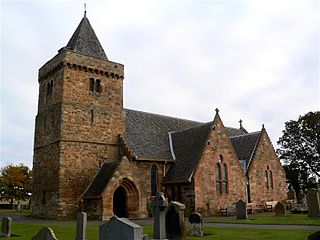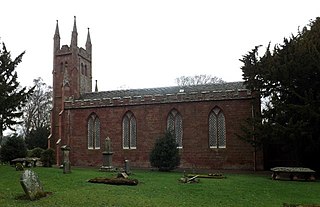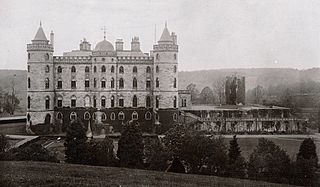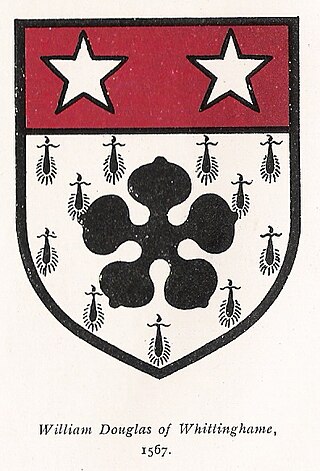
East Lothian is one of the 32 council areas of Scotland, as well as a historic county, registration county and lieutenancy area. The county was called Haddingtonshire until 1921.

Aberlady is a coastal village in the Scottish council area of East Lothian. The village had an estimated population of 1,260 in 2022.
Aberlady Bay in East Lothian, Scotland lies between Aberlady and Gullane.

Whittingehame is a parish with a small village in East Lothian, Scotland, about halfway between Haddington and Dunbar, and near East Linton. The area is on the slopes of the Lammermuir Hills. Whittingehame Tower dates from the 15th century and remains a residence.

Tantallon Castle is a ruined mid-14th-century fortress, located 5 kilometres (3.1 mi) east of North Berwick, in East Lothian, Scotland. It sits atop a promontory opposite the Bass Rock, looking out onto the Firth of Forth. The last medieval curtain wall castle to be constructed in Scotland, Tantallon comprises a single wall blocking off the headland, with the other three sides naturally protected by sea cliffs.

Clan Douglas is an ancient clan or noble house from the Scottish Lowlands.

Henry Stewart, 1st Lord Methven was Master of the Scottish Artillery and third, and last husband, of Margaret Tudor, eldest daughter of Henry VII of England and Elizabeth of York.

Luffness Castle, also known as Luffness House, is a house built in a former fortification near the village of Aberlady, East Lothian, Scotland.

Douglas Castle was a stronghold of the Douglas family from medieval times to the 20th century. The first castle, erected in the 13th century, was destroyed and replaced several times until the 18th century when a large mansion house was built in its place. This too was demolished in 1938, and today only a single corner tower of the 17th-century castle remains. The castle was the former family seat of the Prime Minister, Sir Alec Douglas-Home. The castle was located around 1 kilometre (0.62 mi) north-east of the village of Douglas, South Lanarkshire, in south-west Scotland. The remains are protected as a category C listed building.

Clan Lindsay is a Scottish clan of the Scottish Lowlands.

William Douglas of Whittingehame was a Senator of the College of Justice at Edinburgh, and a Royal conspirator.

The Lord of Liddesdale was a magnate in the medieval Kingdom of Scotland; the territorial lordship of Liddesdale was first created by David I of Scotland, perhaps between 1113 and 1124 when the latter was Prince of the Cumbrians. From an early period the caput of the lordship was Hermitage Castle, the strength of Liddesdale. King David gave the territory to Ranulf de Soules, a knight from the Cotentin Peninsula. It was forfeited by the Soulis family in the 14th century and eventually passed to the Douglases, only to be lost to the Hepburns by order of James IV. Archibald Douglas, 5th Earl of Angus was remunerated for this loss by the lordship of Bothwell Castle, although the Hepburn Earls of Bothwell retained the territorial designation

Redhouse Castle is a ruined tower house castle, 2 km east of Longniddry, East Lothian, Scotland, UK, on the B1377, close to Spittal. The castle designated as a scheduled monument. It is no longer protected as a category A listed building.

Paul de La Barthe de Thermes or de Termes (1482–1562), also Paul de Terme or Maréchal de Thermes, was a French Army Marshal ("Maréchal").
Sir Archibald Douglas of Kilspindie, also known as Greysteil, was a Scottish nobleman and courtier, who served as Treasurer of Scotland, and was three times Provost of Edinburgh.
Isobel Hoppar or Hopper was a Scottish landowner and governess of Margaret Douglas. She was a powerful political figure in Scotland during the youth of King James V, and her wealth and influence attracted misogynous comment from her faction's enemies.

Forter Castle is located in Glenisla, Perthshire, Scotland. It was built in 1560 by James Ogilvy, the 5th Lord of Airlie. In 1640, it was burned by Archibald Campbell, the 8th Earl of Argyll, but it was rebuilt in the early 1990s.

Cavers Castle, also known as Cavers House, is a ruined tower house located at Cavers, Scottish Borders, Scotland. Cavers Castle was a much extended tower house of the Douglas family dating back to the 15th or 16th century, and built upon the site of an earlier stronghold of the Balliols. It was repeatedly attacked during the 16th century wars with England, and substantially remodelled in the 17th century to form a mansion house, itself extended and remodelled in baronial style by Peddie and McKay in the 1890s. It was eventually deroofed and partially demolished in the 1950s, and was sold most recently in 2019. There are developing plans to restore the building, which is a listed building.
Abercorn Castle was a 12th-century castle near Abercorn in West Lothian, Scotland.















